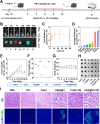Blocking copper transporter protein-dependent drug efflux with albumin-encapsulated Pt(IV) for synergistically enhanced chemo-immunotherapy
- PMID: 40102840
- PMCID: PMC11917112
- DOI: 10.1186/s12951-025-03310-4
Blocking copper transporter protein-dependent drug efflux with albumin-encapsulated Pt(IV) for synergistically enhanced chemo-immunotherapy
Abstract
Non-small cell lung cancer (NSCLC) represents the most prevalent form of lung cancer, exerting a substantial impact on global health. Cisplatin-based chemotherapy is the standard treatment for NSCLC, but resistance and severe side effects present significant clinical challenges. Recently, novel tetravalent platinum compounds have attracted significant interest. While numerous studies concentrate on their functional modifications and targeted delivery, tumor-induced platinum resistance is frequently overlooked. Previous tetravalent platinum compound demonstrated antitumor activity, yet proved ineffective against cells exhibiting resistance to cisplatin. In order to enhance the efficacy and potential applications of tetravalent platinum in NSCLC, a glutathione (GSH)-responsive albumin nanoquadrivalent platinum (HSA@Pt) have been constructed. In light of previous research into drug conjugation, this study was to develop a combined chemo-immunotherapy approach. The HSA@Pt demonstrated high efficacy and low toxicity, with targeted tumor accumulation. Furthermore, Ammonium Tetrathiomolybdate (TM) has been demonstrated to exert a synergistic inhibitory effect on ATPase Copper Transporting Beta (ATP7B) and Programmed Death Ligand 1 (PD-L1), impede platinum efflux, induce cellular stress, and activate antitumor immunity. The findings suggest HSA@Pt's potential for clinical use and a novel chemo-immunotherapy strategy for NSCLC, enhancing the utility of established drugs through synergistic sensitization.
Keywords: Albumin; Ammonium Tetrathiomolybdate; NSCLC; Novel tetravalent platinum; Tumor chemo-immunotherapy.
© 2025. The Author(s).
Conflict of interest statement
Declarations. Ethics approval and consent to participate: All animal experiments were conducted in accordance with the guidelines of Hunan SJA Laboratory Institutional Animal Care and Use Committee (SJA2022128). Consent for publication: Consents for publication were obtained from all the authors of this study. Competing interests: The authors declare no competing interests.
Figures







Similar articles
-
Disruption of Iron Homeostasis to Induce Ferroptosis with Albumin-Encapsulated Pt(IV) Nanodrug for the Treatment of Non-Small Cell Lung Cancer.Small. 2023 Dec;19(49):e2206688. doi: 10.1002/smll.202206688. Epub 2023 Aug 22. Small. 2023. PMID: 37606911
-
Expression of copper-transporting P-type adenosine triphosphatase (ATP7B) correlates with cisplatin resistance in human non-small cell lung cancer xenografts.Oncol Rep. 2008 Aug;20(2):265-70. Oncol Rep. 2008. PMID: 18636185
-
Bioorthogonal Chemistry-Guided Inhalable Nanoprodrug to Circumvent Cisplatin Resistance in Orthotopic Nonsmall Cell Lung Cancer.ACS Nano. 2024 Nov 19;18(46):32103-32117. doi: 10.1021/acsnano.4c10947. Epub 2024 Nov 9. ACS Nano. 2024. PMID: 39520399
-
Modulating Chemosensitivity of Tumors to Platinum-Based Antitumor Drugs by Transcriptional Regulation of Copper Homeostasis.Int J Mol Sci. 2018 May 16;19(5):1486. doi: 10.3390/ijms19051486. Int J Mol Sci. 2018. PMID: 29772714 Free PMC article. Review.
-
Single or combined immune checkpoint inhibitors compared to first-line platinum-based chemotherapy with or without bevacizumab for people with advanced non-small cell lung cancer.Cochrane Database Syst Rev. 2020 Dec 14;12(12):CD013257. doi: 10.1002/14651858.CD013257.pub2. Cochrane Database Syst Rev. 2020. Update in: Cochrane Database Syst Rev. 2021 Apr 30;4:CD013257. doi: 10.1002/14651858.CD013257.pub3. PMID: 33316104 Free PMC article. Updated.
Cited by
-
Cuproptosis: a novel therapeutic mechanism in lung cancer.Cancer Cell Int. 2025 Jun 24;25(1):231. doi: 10.1186/s12935-025-03864-1. Cancer Cell Int. 2025. PMID: 40555995 Free PMC article. Review.
References
-
- Siegel RL, Giaquinto AN, Jemal A. Cancer statistics, 2024. CA Cancer J Clin. 2024;74:12–49. - PubMed
-
- Wu YL, Tsuboi M, He J, John T, Grohe C, Majem M, Goldman JW, Laktionov K, Kim SW, Kato T, et al. Osimertinib in resected EGFR-Mutated Non-Small-Cell lung Cancer. N Engl J Med. 2020;383:1711–23. - PubMed
-
- Zenke Y, Tsuboi M, Chiba Y, Tsujino K, Satouchi M, Sawa K, Shimizu J, Daga H, Fujimoto D, Mori M, et al. Effect of Second-generation vs Third-generation chemotherapy regimens with thoracic radiotherapy on unresectable stage III Non-Small-Cell lung cancer: 10-Year Follow-up of a WJTOG0105 phase 3 randomized clinical trial. JAMA Oncol. 2021;7:904–9. - PMC - PubMed
-
- Yang JC, Lee DH, Lee JS, Fan Y, de Marinis F, Iwama E, Inoue T, Rodriguez-Cid J, Zhang L, Yang CT et al. Phase III KEYNOTE-789 study of pemetrexed and platinum with or without pembrolizumab for tyrosine kinase Inhibitor–Resistant, EGFR-Mutant, metastatic nonsquamous Non-Small cell lung Cancer. J Clin Oncol 2024:JCO2302747. - PMC - PubMed
MeSH terms
Substances
Grants and funding
- 2024ZZTS0286/the Independent Exploration and Innovation Project for Graduate Students of Central South University
- CX20240332/the Hunan Provincial Graduate Student Research and Innovation Program
- 82204531/the National Natural Science Foundation of China
- 82073943/the National Natural Science Foundation of China
- 82474012/the National Natural Science Foundation of China
LinkOut - more resources
Full Text Sources
Research Materials

